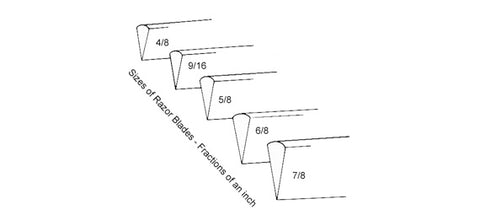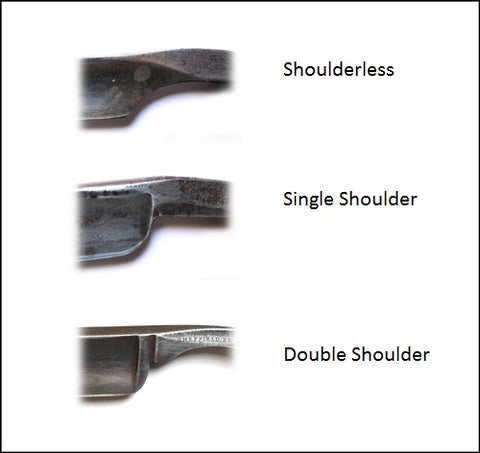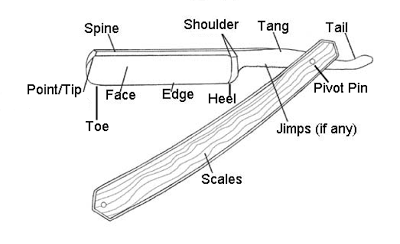
This is our Buyer's Guide to help you figure out exactly what the differences are between individual cut throat razors so that you can make the best-informed decision when selecting one for yourself.
The purpose of this is to explain what goes into a razor, the different components, variations, styles, and practical impacts. There are a lot of different designs that can be just for aesthetics or they can have very real changes in performance and ease of use.
In this guide we will be covering the following variations:
So let's get straight into it with one of the most common variables.
Steel Type
The two most common types of steel used by high-quality manufacturers are carbon steel or stainless steel. This can be quite a controversial and heated topic because the manufacturing process (especially heat treatment and tempering) can have even more influence on razor behaviour than the type of steel.
However in general (and simplistic) terms:
Carbon steel takes longer to hone but holds its edge for longer
Stainless steel loses its edge more quickly but is more resistant to rust and corrosion
We generally prefer carbon steel razor blades because poor quality suppliers and manufacturers often use stainless steel without proper hardening which is like shaving with a blunt butter knife.
But as I mentioned above, a high-quality manufacturer can make premium razors out of either steel type.
Blade Width
The difference in blade width can generally be thought about in terms of the weight of the razor and the ease in which to maneuver around those difficult to access areas like under your nose.
They are generally measured as a fraction of an inch.

3/8" and 4/8" razors are the smallest but have advantages of their own. They have the best ability to access under your nose and upper lip and provide more feedback which can make it easier to know exactly where the razor is.
5/8" and 6/8" is generally what I would consider 'normal.' They are middle of the available ranges and so are relatively easy to shave with and relatively light. These are the most common razors and are highly recommended for beginners.
7/8" and 8/8" are the larger size. Their advantage is the extra weight which means that there is less resistance provided by the hairs and you can get a good shave with a less sharp razor. However, they can be more difficult to maneuver around. They also have an added advantage of having more surface area to hold lather so they don't need to be wiped off as often.
Cross Section / Grind
The cross-section of the blade is a secondary influencer of total razor weight - for example, a full wedge razor has more steel in the blade than a full hollow.
The diagram below shows the most common grinds and what they look like when viewed from the point.

There is also a grind known as a singing hollow - which is an extremely hollow razor and is called singing based on the sound it makes while shaving.
The main purpose of a hollow grind is to make honing easier as the bevel of the razor should be aligned with the spine meaning that the rest of the steel present in a full wedge is away from the honing stone.
Point Type
The sharp and style of the point or tip of the razor blade is both a combination of aesthetic design and performance.

Round points are the most common and more forgiving style. It is what I would highly recommend for beginners as it does not have any sharp points that can cause a cut with a wrong angled pass.
Flat/square/spike points provide more ability to access difficult to reach areas - such as under your nose, under your ear, etc. They are also less forgiving as the sharp point can cause cuts to an inexperienced shaver if using an incorrect angle.
A Barber's notch has a combination of a round point with a cut taken out. The purpose of this is to provide the safety of a round point but with the added flexibility of being able to access around the nostrils and lip.
Shoulder Style
The shoulder of a razor can be classified in three ways - shoulderless, single shoulder or double shoulder. The shoulder stabilizes the razor which can be particularly important for the thinner grind razors.

Blade Finishing
The finishing on the blade is purely about appearance and does not have any impact on the performance of the razor or the quality of the steel. Generally, it can be categorized into two categories although there are a variety of differences in between.
Polished - a mirror-polished finish is after the blade has been extensively polished to try and make it as shiny as possible.
Satin - a satin-finished is more like a 'brushed-steel' look made up of a multitude of fine scratches.

Frequently Asked Questions
How long does a straight razor last for?
As long as you maintain your razor properly it can last for generations. There are lots of Cut Throat Club members who still use their grandfathers razor.
This means to store it out of high humid environments, hone it when it needs it but not too often, apply oil if storing it for long periods, and replacing any components if they break over the years.
Why are straight razors expensive?
High quality straight razors are made by skilled craftsman using high quality materials in both the steel type and the handle.
You can purchase cheap straight razors but I have found they use lower quality steel which does not hold its edge for long and does not get sharp enough to get a smooth shave.
Does a straight razor give a better shave?
Yes, and the reason is because there is nothing between the blade and your skin. There are no safety guards that are present in a safety razor, which means that you will have more contact between blade and skin.
This also means you should pay more attention to your shaving soap and lather as you will need as much lubrication as you can.
How long does a straight razor stay sharp?
I recommend that you strop your razor after every 1-2 shaves and hone it every 2-3 months. This will make sure that your cut throat razor stays sharp all year round. Make sure you pay attention to when your razor starts pulling against your facial hair which is a good indication that it needs to be sharpened.
Conclusion
That brings us to the end of our cut throat razor buyer's guide. I hope you gained some knowledge that will help your purchase decision.
See our range of cut throat razors here - each razor has its own data sheet so you can see exactly what you are getting.
Please leave a comment below with any questions or comments of your own. We love to interact with our customers and readers.

Conclusion - Phew!
That is everything. If you are interested in shopping with us then check out the Cut Throat Club's product range.
We would love to get your input on any differences of opinion you have or other lessons you have learned that our readers would value - Please leave a comment below.
2 comments
I have a blue wonder 145 razor in the box looks new wondering if anyone can help me with more information on thanks john
Great advice, helped a lot for when deciding on what suits me best.